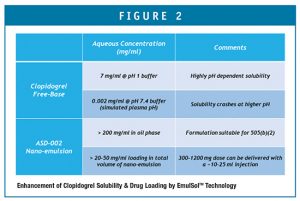Issue:May 2020
FORMULATION FORUM - Application of Nano-Emulsion Technology to Address Unmet Medical Needs: A Case Study of Clopidogrel IV by 505(b)(2) Pathway
Emulsions, which are composed of nano-sized droplets dispersed in a continuous phase, can be classified into either oil-in-water (O/W) or water-in-oil (W/O). Emulsions have many practical applications in the agriculture, food, cosmetic, pesticide, and pharmaceutical industries. Emulsions can be used to deliver active ingredients by multiple routes of administration, such as topical, oral, nasal, ophthalmic, or injectables. Oil-in-water emulsions have gained significant application in the drug delivery of lipophilic drugs or nutrition supplements by parenteral, oral, and topical routes of administration, whereas water-in-oil emulsions have increased their application for delivery of hydrophilic small molecules and biologicals, such as large molecules, DNA, RNA, and peptides.
As a result of small droplet size as low as <100 nm, the large surface area, and a reduction in surface tension, nano-sized emulsions can provide unique solutions for overcoming drug solubility, permeability, and stability problems. There are two types of nano-sized emulsions: nano-emulsions, which are a kinetic stable system that only require low level of surfactant of below 10%, and micro-emulsions, which are thermodynamic system, but require a high level of surfactant up to >50%. The distinction between micro-emulsions and nano-emulsions relates to their thermodynamic stability. Micro-emulsions are thermodynamically stable due to the use of sufficient co-solvents and surfactants to prevent Ostwald ripening – essentially the coalescence of the droplets into larger particles. Ostwald ripening is the most frequent instability mechanism, although gravitational separation can also occur with larger particles.1 Nano-emulsions contain much less of the surfactants, and as such, are meta-stable and more susceptible to Ostwald ripening. In addition, nano-emulsions require greater kinetic formation energy, and are usually prepared using high-pressure homogenization, microfluidics, or ultrasonic generators. However, a well-formulated nano-emulsion will maintain its physical-chemical stability through its shelf-life of at least 2 to 5 years. Because of the undesirable side-effects caused by many solvents and surfactants (in fact, the FDA places daily intake limits on such ingredients), microemulsions are disadvantageous compared to nano-emulsions for use in human by parenteral route.
In addition, nano-emulsions possess benefits in improving drug solubility, loading and stability, reduction of injection pain and thrombophlebitis, enabling of targeted drug delivery, and reduction of drug toxicity. A few lipid-based nano-emulsion pharmaceutical products have been marketed in the past years (Table 1).
EMULSOLTM TECHNOLOGY
A drug’s low solubility often presents a serious challenge to developing bioavailable dosage forms. This challenge can be exacerbated for drugs with chemical stability issues when solubility-enhancing approaches utilize excipients that are incompatible with the drug substance. To overcome these challenges, many technologies have been developed, including particle size reduction to nanometer-size drug crystals with greater surface area for dissolution, production of amorphous solid dispersions for reducing the energy required for dissolution, and lipid-based drug delivery systems for dissolving a hydrophilic drug in either a lipid or oil phase. However, not all of these technologies are suitable when the drug is both poorly soluble and chemically unstable. In particular, the use of nano-emulsions is a growing area due to their ability to formulate poorly soluble drugs for multiple routes of administration – drops or creams for topical products, suspensions for pediatric products, and sterile, parenteral forms for injection, and to potentially shield the active ingredient from chemical degradation.2
Despite their advantages, nano-emulsions have certain limitations. The oil droplet particle size may increase over time via Ostwald ripening – this physical instability can lead to loss of optical clarity and potentially a decrease in drug solubility as the interfacial surface area decreases. In order to achieve physically stable nano-emulsions, long-chain triglyceride oils are sometimes employed, but typically require the use of organic co-solvents or toxic co-surfactants (eg, Cremaphor). The addition of co-solvents and co-surfactants significantly reduces the safety and tolerability profile of the pharmaceutical formulation. These excipients may not be suitable for pediatric administration, may cause injection site pain and irritation, and are becoming less acceptable in general for use in pharmaceutical formulations. With deep understanding of lipid chemistry and its interaction with drug and utilizing a tailored formulation approach, Ascendia developed a proprietary technology, EmulSolTM for production of novel oil-in-water nano-emulsions.
Ascendia’s EmulSol technology produces stable, optically clear nano-emulsions without the use of organic solvents and with minimal use of surfactants using a high-pressure or microfluidic homogenization process. By selecting a specific lipid carrier in combination with a surfactant and/or co-surfactant and a unique process, Ascendia has eliminated the use of organic solvents in its formulation approach. EmulSol formulations are prepared using a robust, commercial-scale homogenization process, but with a proprietary combination of lipid carrier and surfactants – the resulting emulsion of oil droplets in the water phase is physically stable and safer for IV administration. The elimination of solvents from the formulation reduces injection site irritation and is more acceptable for pediatric, IV, and ocular products; and the minimization of surfactants improves the safety and chemical stability of the resulting nano-emulsion formulation. Ascendia has used its EmulSol technology to formulate its lead pipeline products – ASD-002, a novel injectable form of the anti-thrombotic drug clopidogrel, and ASD-004, a clear emulsion cyclosporin eyedrop for dry eyes.
CASE STUDY OF ASD-002: INJECTABLE CLOPIDOGREL
Clopidogrel, first approved in 1997, was co-developed and co-marketed (as Plavix®) by Bristol-Myers Squibb and Sanofi. Clopidogrel is one of the leading anti-thrombotic drugs in use today, and as recently as 2011, was the second best-selling drug product in the world, achieving over $7 billion in sales that year. Clopidogrel is indicated for Acute Coronary Syndrome (ACS), and also following recent myocardial infarction, stroke, or in established peripheral arterial disease. In particular, ACS refers to unstable angina or when blood supply to the coronary arteries becomes suddenly fully or partially blocked (ie, heart attack). However, in the current medical practice, there is unmet medical need in the fast onset of P2Y12 agent in patients prior to urgent PCI procedure. When a patient presents with a suspected coronary event, a 300- to 600-mg loading dose of clopidogrel is frequently administered. However, the only commercially available dosage forms of clopidogrel are oral tablets in 300-mg and 75-mg strengths – not ideal for administration in an emergency setting. Also, when delivered orally, there is a significant delay in the time (2 to 5 hours) required for the medicine to become effective, although clopidogrel is rapidly absorbed, the time to reach peak concentration and at a low dose therapeutic effect can require several hours. Therefore, in an acute, emergency setting, for a higher dose of 300-600 mg a more rapidly acting, injectable clopidogrel dosage form is desirable.
The barrier to developing such a product is due to clopidogrel’s challenging solubility, physical form, and chemical stability properties. Clopidogrel is a weak base with a pKa of 4.5, and it is practically insoluble in water at neutral pH (the oral tablet composition uses the bisulfate salt form of clopidogrel, which is soluble at gastric pH, but not suitable for injection). Clopidogrel free-base is a semisolid, viscous, oily form, thus presenting difficulties in storage, dispensing, and processing. Moreover, the free-base form is chemically unstable and undergoes both hydrolysis and oxidation. In addition, clopidogrel is a chiral molecule: only the senantiomer is biologically active, and chiral conversion to the r-enantiomer can easily occur in a liquid dosage form.
There have been development efforts to formulate and clinically test an injectable clopidogrel dosage form. Ligand licensed an injectable clopidogrel formulation (developed by Prism using Cydex’s cyclodextrin-based technology platform) to The Medicines Company in 2011.3 Other injectable formulations have been studied clinically.3 And the patent literature also discloses attempts to formulate stable parenteral dosage forms.4 However, despite the development efforts to date, and the clear unmet medical need, an injectable form of clopidogrel has not been successfully developed and approved.
Using its EmulSol technology, Ascendia has developed a novel oil-in-water nano-emulsion formulation of clopidogrel. The goal of the development program has been to demonstrate successful formulation of clopidogrel free-base in a nano-emulsion suitable for injection, having acceptable chemical and physical stability properties. Because the formulation contains no solvent, the risk of injection site pain is greatly reduced. And, even though the free-base is poorly soluble at plasma pH, when contained in the oil phase of the nano-emulsion, the clopidogrel drug substance becomes much more soluble as shown in Figure 2.
The ASD-002 nano-emulsion is prepared by a unique high-pressure and high-shear process using Ascendia’s proprietary technology. Another challenging aspect of this development program is the demonstration of chemical and physical stability. Clopidogrel has several degradation pathways, including oxidation (Impurity A), hydrolysis (Impurity B), and chiral conversion (Impurity C). Ascendia has investigated the degradation pathways of clopidogrel free-base and clopidogrel bisulfate in aqueous solution, and developed stability-indicating analytical methods. Ascendia has demonstrated physical stability of the formulation by showing minimal change in oil droplet particle size following either autoclaving the formulation, or a freeze-thaw cycle for the formulation – the mean particle size remains a consistent nano-range size. Chiral conversion to the r-enantiomer is the predominant chemical impurity. Ascendia has shown in accelerated stability studies that chiral conversion is kept within USP limits for sufficient time to provide a commercially acceptable product shelf-life. ASD-002’s stability profile has been compared to other aqueous-based liquid formulations (eg, cyclodextrin-based liquid forms) of clopidogrel and demonstrates superior chemical stability with respect to all three major impurities – chiral degradation, oxidation, and hydrolysis (Figure 3).
SUMMARY
Emulsion drug delivery systems have tremendous potential for customized delivery of both lipophilic and hydrophilic drugs in different routes of administration. Nano-emulsions are particularly useful in developing liquid formulations of poorly water-soluble drugs for injectable administration. Oil-in-water nano-emulsions can be used to stabilize drugs, to increase drug loading, to reduce injection site reaction, and to achieve unique drug PK/PD profiles.
Despite the past challenges that prevent development of a soluble, stable form of the anti-thrombotic drug clopidogrel in a suitable parenteral form, using its EmulSol technology, Ascendia has successfully developed a novel oil-in-water nano-emulsion formulation of clopidogrel, whereby the insoluble and unstable free-base form of clopidogrel is converted to a form with acceptable drug loading and is protected from chemical degradation.
A ready-to-use, nano-emulsion, parenteral form of clopidogrel with a faster and higher PK/PD effect and a higher single dose >300 to 1200 mg is moving forward into development for human BA/BE studies under the NDA 505(b)(2) pathway. Ascendia is exploring further clinical development and partnering opportunities for this unique product.
REFERENCES
- Bernardi D, Pereira TA, Maciel NR, Bortoloto J, Viera GS, Oliveira GC, Rocha-Filho PA. Formation and stability of oil-in-water nanoemulsions containing rice bran oil: in vitro and in vivo assessments. Journal Nanobiotechnol. 2011;9:44.
- Troy Harmon, Jim Huang, Nanoemulsion formulation for injectable and oral administration, Drug Development & Delivery, Vol (14)-8, 34-38.
- Ligand Pharmaceuticals press release 03 June 2011.
- Cushing DJ, Souney PF, Cooper WD, Mosher GL, Adams MP, Machatha S, Zhang B, Kowey PR. Pharmacokinetics and platelet aggregation inhibitory effects of a novel intravenous formulation of clopidogrel in humans. Clin Exp Pharmacol Physiol. 2012;39(1):3-8.
To view this issue and all back issues online, please visit www.drug-dev.com.

Jim Huang, PhD
Founder & CEO
Ascendia Pharmaceuticals
j.huang@ascendiapharma.com
www.ascendiapharma.com
Total Page Views: 7944














